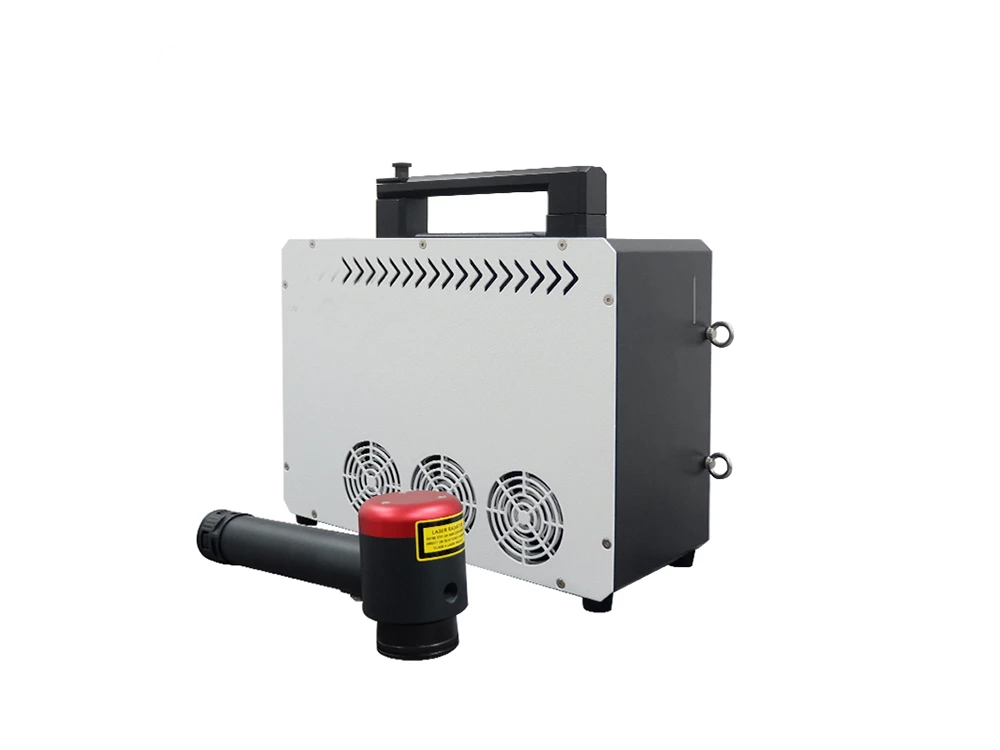Introduction:
The laser cleaning machine has gained popularity for its efficiency in eliminating rust. These machines are traditionally used on metals. But they also have sparked interest in applicability to non-metal surfaces, such as wood.
Can moldy wood be cleaned with a laser cleaning machine? Yes. Pulse laser cleaning machines can do it. How is the cleaning effect? Will it burn during cleaning? This article will explore the safety and effectiveness of a pulse laser cleaning machine when used on wood surfaces.
Features of Pulse Laser Cleaning Machine

1. Effective Dust Removal
They can effectively remove fine particles, dust, and contaminants from surfaces. The pulsating air or gas bursts create shockwaves that dislodge particles. This ensures a comprehensive cleaning process.
2. Continuous Operation
Pulse cleaning systems allow continuous equipment operation without significant downtime for cleaning. This is crucial for industries where uninterrupted production is a priority.
3. Automation and Programmability
They have automated control systems that allow programmed cleaning cycles. Automation reduces the need for manual intervention, ensuring timely and consistent cleaning.
4. Energy Efficiency
The pulse cleaning system is energy-efficient. They use compressed air judiciously, optimizing the cleaning process. This minimizes overall energy consumption.
5. Versatility in Applications
Pulse laser cleaning machines can be adapted for use in various applications. These include industrial equipment, dust collector systems, and other surfaces prone to contamination. Their versatility makes them suitable for diverse industries.
6. Low Maintenance Requirements
They are often designed with low maintenance requirements. This reduces the frequency of maintenance tasks, leading to lower overall maintenance costs.
7. Environmental Compliance
Pulse cleaning systems include features to control emissions, ensuring compliance with environmental regulations. This is particularly important in industries where environmental responsibility is a priority.
8. Customization Options
Some pulse laser cleaning machines offer adjustable settings. This can customize the cleaning intensity based on the application’s specific requirements. This allows users to tailor the cleaning process to different materials and contamination levels.
The Process Of Cleaning Wood With Pulse Laser Cleaning Machine
The cleaning equipment used in the video is a pulse laser cleaning machine. We can see from the video that the mildew was cleaned quite thoroughly and did not cause the wood to burn or turn black. Since wood is flammable, be careful when choosing laser cleaning equipment. The flat-top beam profile emitted by the laser device does not have wings. But it has steeper edge transitions, making energy utilization more efficient. This also causes less damage to the surrounding area.
Equipment installation
1. Connect the power line of the equipment to the power supply circuit breaker. Pay attention to the matching of electrical power and voltage. The equipment ground wire must be connected to the standard ground wire terminal.
2. Open the water inlet of the water tank and add pure water (industrial distilled water). Some water tanks need to have the exhaust valve open to add water. (See the water tank instructions for details) Just add water to the water level of the water tank.
Boot process
1. Confirming that the external power connection is normal. Open the circuit breaker at the rear of the equipment.
2. Check whether the emergency stop switch is turned on normally. After confirming that it is turned on, turn on the key switch. At this time, the machine power indicator light will light up.
3. Confirm that the equipment is powered on normally at this time. Check whether the chiller is working normally and the water circuit of the equipment is normal. If water leaks or the chiller is not working, please cut off the power and check.
4. Turn on the laser and select the external control mode. The specific method differs due to different laser brands. Please consult the relevant technical personnel before starting it up for the first time.
5. After the laser self-test process is completed, you can operate the touch screen on the device to adjust the laser power. The laser self-test process takes about 30 seconds; please wait patiently.
6. Click on the interface. Wait for the light preparation warning to sound. Then, you open the lens protective cover. You can perform cleaning work by touching the button on the handgun (twice to light up). When the light is out, find the focal length height with the largest spark. This is the optimal cleaning height.
Shutdown process
1. Click the laser and swing buttons on the controller’s touch screen.
2. Hang the handgun on the holder and close the water tank button.
3. Turn off the key switch and organize the fiber optic cables.
4. Close the circuit breaker at the rear of the equipment.
Precautions When Working with Pulse Laser Cleaning Machine
1. The optical fiber cannot be bent more than 60 degrees and cannot be pressed with heavy objects. The laser gun head must be handled with care. When not in use, please hang it on the rack.
2. Laser equipment is precision equipment. Don’t place the equipment prone to electromagnetic interference and power grid interference too close. Keep a distance of more than 5 meters, and the same power cord cannot be shared.
3. The laser will alarm (yellow light turns on) when the water temperature is within 8 degrees. Please turn off the laser and run the water tank for 40 minutes.
4. If the energy is uneven or too small, please check whether the protective lens in the handheld welding gun is burned out. When checking, please make sure the equipment is turned off.
5. Please wear protective gloves and laser protective glasses when performing laser work.
6. Pointing the gun tip at people during work is strictly prohibited. Please click the interface close button when stopping use or temporarily suspending use.
7. When cleaning some highly reflective materials, please consider high-temperature reflective areas. (aluminum plate, galvanized plate)
